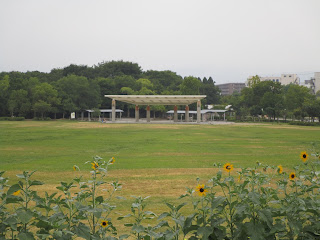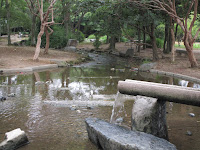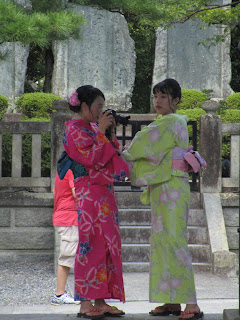So, over the last several weeks my most prominent thought about Japan's summer had to do with how insanely hot and humid and miserable it feels. However, after my recent trip to Kyoto (which was no less hot) I was reminded that the summer time is also beautiful in Japan. For everything there is a season - especially in Japan where the decor and diet follow the climate - and I almost missed out on the delights of summer.
So here is my list of the things I will miss when summer comes to an end.
The Greenery
There are two different kinds of green which I are a part of Japan's summer: the light green of sunflowers reaching for the sun (shown in the picture above) and the dark green of moss and gardens coming to life in the shade.
The Cicadas
Every time I hear the cicadas I think of this scene in Kenshin (https://www.youtube.com/watch?v=4jk39k0kInk) and in a Japanese summer that is every time I go outside. In fact, the cicadas in the park near my house are often loud enough for me to hear them through my apartment walls in the morning. Yet there weren't any cicadas in the spring.
Summer flowers
Spring also had lovely flowers like cherry blossoms, roses, tulips, hydrangea, etc... But the perpetual green and blossoms of the summer is a different kind of amazing. Instead of being beautiful because of their contrast with the surroundings like spring flowers are, summer flowers are satisfying because of their complete assimilation into the greenery around them. They just seem to fit. In church every Sunday the older women bring flowers (which, of course, perfectly match the outdoor season) and the summer bouquets are, by far, my favorite because of the fullness of life that they display.
Yukata
The yukata is a traditional Japanese outfit which is the summer equivalent of a kimono. There are girl and boy yukatas and you can usually find dozens of people wearing them at fireworks displays or festival (which occur almost every week in the summer). They are just as pretty as the flowers of the summer - beautiful in their own right and yet the perfect compliment for the decor of a festival. You can always hear if someone in a yukata has gone all out because the traditional yukata is worn with a wooden flip-flop that makes a unique sound when you walk.
Sightseeing and History
Let's not forget sightseeing. While the weather may be unbelievably hot, summer time does mean that everything is green: trees, bushes, grasses, and vines. They are the perfect accent for the ancient wooden buildings in which are central to Japanese sightseeing adventures. (The photo below with the car is intended to demonstrate how narrow the streets are in some cities.)

Families
Summer time is also a time when most children have less school, meaning that you can see more families together on vacations. For anyone who enjoys people watching, I think you will agree that is is much more fun to see the energy of delighted children and their families. Such unmitigated delight is contagious. I see them in parks, at the beach, at festivals, and on in shopping malls.


















































